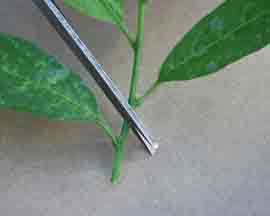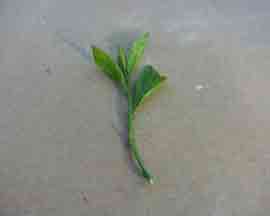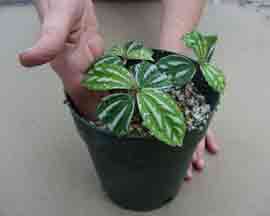One of the easiest and fastest ways to get new plants is from herbaceous cuttings. The Hoosier Gardener demonstrateshow to make these cuttings and pot them up Aug. 11, 2010 on the Morning News at Indianapolis’ Fox 59.
Begonias, impatiens, geraniums and coleusare just a few of the annuals growing in the garden now that can be propagated this way. These plants can be grown indoors in a bright sunny window for enjoyment long past the summer season. Houseplants and perennials also can be propagated through herbaceous cuttings.
Here’s how to take herbaceous cuttings:
- Water the plants well the day before.
- Clean your snips, scissors, knife or other tools with a solution that is 1 part bleach and nine parts water. This is called a 10-percent bleach solution and can be used to clean all garden tools, pots and other items to keep from spreading disease from plant to plant.
- Prepare the new pot where the cutting will be planted. The pot should be cleaned with the 10 percent bleach solution.
- Use high-quality, sterile potting mix, vermiculite, perlite or sand as the rooting medium. The rooting medium should be well drained, but moist.
Take cuttings only from healthy, actively growing plants.
- The cutting should be 2- to 6-inches long. Make the right-angle cut below where a leaf is attached to the stem, called the leaf node.

Cut large leaves in half on herbaceous cutting to reduce moisture loss. Photo courtesy Purdue University
Remove one-third to one-half of the leaves and any flower buds from the cutting. If the leaves that remain are large, cut them in half. By removing leaves and reducing their size, you reduce the cutting’s loss of moisture.
- Dust the lower inch of the cutting in a rooting hormone, available at garden centers. Some have a fungicide in the mix and some are just a straight rooting hormone. A fungus that causes dampening off can destroy some cuttings.
- Use a pencil, screwdriver or your finger to make a hole in the rooting medium.
- Insert the cutting in the hole. You can place more than one cutting in a pot. Gently press the soil around the cuttings.
- Place a clear plastic bag over the cutting and the pot, making sure the plastic does not touch the plant. Use toothpicks, bamboo stakes or chopsticks to keep the plastic away from the plant, if needed.
- Place the pot out of direct sunlight, but in a bright, warm spot.
- Check the pot every few days for soil moisture and to shake out the condensation that forms in the plastic bag.

You can place more than one herbaceous cutting in a pot filled with a sterile potting medium. Photo courtesy Purdue University
After a two weeks, check to see if the plant has rooted by gently pulling on it. If there is resistance, the cutting has likely rooted. If not rooted, check again in a week.
- When the cutting has rooted, vent the plastic bag for a few days.
- Transplant the cutting to its permanent pot and move to its new location.




This is great information. I tried some of these techniques last year when I first started growing in my greenhouse. It is a great way to FILL the house! Thank you for sharing this information Jo Ellen – your blog is like a Magazine!